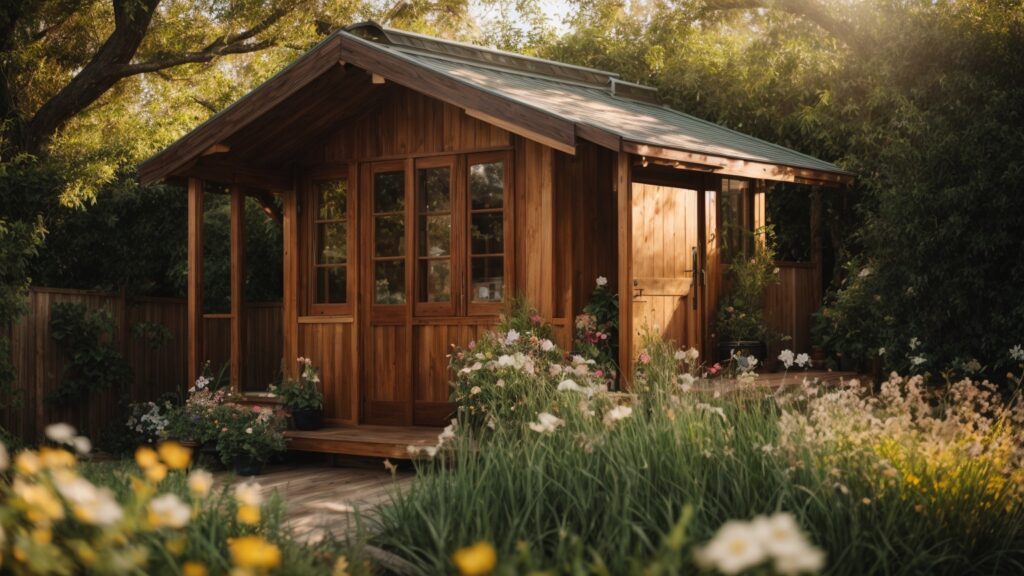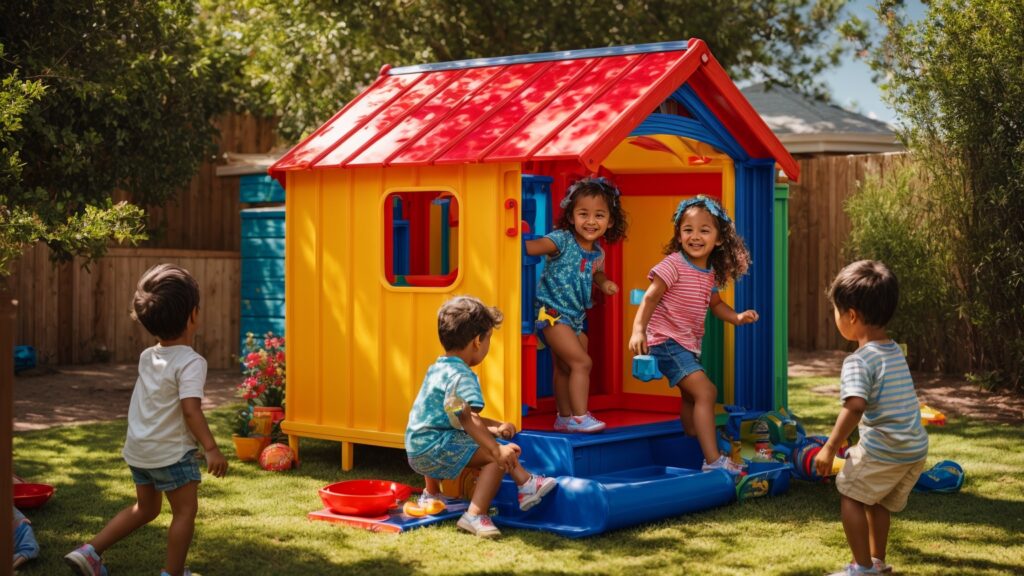Estimated reading time: 10 minutes
- Razee Large Playhouse Tent Indoor
- Play House Kids Tent Castle Tent for Girls Boys
- Play Cottage (Grey)
Introduction
When looking into what is a cubby house, it’s clear these spaces are much more than areas for children to play. They are crucial for the growth and development of young minds. Cubby houses offer kids a unique opportunity for play, stimulating their imagination and creativity. These areas provide a setting where children have the control to create their surroundings, using play equipment such as slides, monkey bars, and swing sets to enhance their adventures.
Beyond providing fun, cubby houses play a significant role in the development of children. They support cognitive, social, and emotional growth in toddlers and older children. Features like a sandpit, the ability to customise, or the addition of a ladder can enrich the learning experiences in these play areas. Positioned as a focal point in a garden or play area, cubbies become central to children’s activities, teaching them valuable skills in cooperation, sharing, and empathy. This environment, filled with imaginative play, is pivotal in preparing children for future challenges, equipping them with essential skills for navigating life.
Key Takeaways
- Cubby houses are crucial for encouraging a child’s imagination and creativity, going beyond mere areas for activity.
- These play spaces serve as an important environment for children, aiding in their cognitive, social, and emotional development through play.
- The background and changes in cubby houses showcase their widespread cultural importance and transformation from basic shelters to intricate play settings.
- Cubby houses provide a space where children can claim ownership and independence, promoting creative play and story creation.
- The variety in cubby houses designs and materials, ranging from wooden to cardboard, accommodates various tastes and sparks inventiveness.
- Active participation from parents and educators in cubby house activities boosts its role as an educational and developmental instrument, making the play experience more meaningful.
Understanding Cubby Houses: Definition and History
Cubby houses stand as a pivotal centre for kids’ play, embodying the essence of exploration and creative expression. These distinctive play spaces, ranging from basic shelters to intricate mini-homes, provide children with their personal area for adventures and creativity. The phrase cubby house, deeply ingrained in certain cultures, conjures visions of backyard retreats that reflect the inventive spirit of childhood. Initially simple shelters, these areas have transformed into complex settings where children partake in diverse activities, from imaginative play to tranquil spots for reading. Cubby houses are more than just physical buildings; they symbolize a domain where imagination sets the boundaries, serving as a lasting icon of childlike wonder and autonomy.
What Makes a Cubby House Special:
- It’s a child’s private space where they can feel a sense of ownership and independence.
- Cubby houses are instrumental in nurturing a child’s imaginative play, allowing them to create their own narratives and adventures.
The Architectural Diversity of Cubby Houses
From cardboard playhouses that inspire DIY projects to elaborate wooden cubby houses that mimic real homes, the architectural diversity of cubby houses is vast. Some families opt for castle-themed structures with turrets and flags to spark medieval adventures. Others prefer more traditional designs, reminiscent of quaint cottages.
The materials used in constructing a cubby house play a significant role in its character and durability. While wooden structures offer sturdiness and a classic look, cardboard cubby houses are eco-friendly and customizable. Whichever material is chosen, the cubby house becomes a child’s personal wonderland.
Cubby Houses in Pop Culture
Cubby houses have made their mark in popular culture as well. They’ve been featured in children’s literature, movies, and TV shows, often symbolizing a place of refuge and creativity. A notable example is the cubby house owned by Queen Elizabeth in her childhood, demonstrating the universal appeal of these play spaces.
The Benefits of Cubby Houses for Child Development
Cubby houses are key in supporting child development, providing more than mere areas for kids to play. These environments encourage a blend of entertainment and education, where children can discover, imagine, and advance. Inside a cubby house houses, children are inspired to forge their own universes, fostering their inventiveness and problem-solving abilities through play. Engaging with these structures aids in cognitive growth and promotes social skills as kids partake in group play activities. Playing in cubby houses also aids emotional development, offering a feeling of safety and community. In essence, cubby houses present a comprehensive setting for children to acquire crucial skills in a fun and captivating way.
“Cubby houses provide a unique setting where children can develop essential life skills in a safe and controlled environment. It’s where they learn to think, solve, and socialize.” – [Early Childhood Educator]
Section Summary:
- Cubby houses facilitate cognitive development through imaginative play.
- They offer a social and emotional learning environment, teaching children cooperation, empathy, and boundary-setting.
The impact of cubby houses on child development cannot be overstated. They are more than play areas; they are vital tools that aid in the holistic development of a child, preparing them for the world’s complexities in a space of safety and joy.

Building and Designing a Cubby House
Creating a cubby house taps into the core of kids play. When looking to buy a cubby house, it’s important to think about the type of cubby that will captivate your kids. Elevated cubby houses and play houses, like the attractive cottage cubby, offer diverse play experiences. Cubby houses come in various styles, from simple kids cubby setups to elaborate cubby houses and forts, all aimed at enabling children play and letting their imagination run wild. Choosing a good quality wooden cubby can extend its lifespan, with timber being a preferred material for those purchasing a cubby. Whether it’s for tea parties or imaginative activities, picking the right cubby is key to delivering endless enjoyment for young kids. Seeing kids love their new play space is incredibly rewarding, highlighting the importance of selecting the best option to enrich their playtime and creative explorations.
| Material | Pros | Cons | Best For |
|---|---|---|---|
| Wooden | Durable, classic look, weather-resistant | Heavier, requires maintenance | Permanent outdoor structures |
| Cardboard | Lightweight, customizable, eco-friendly | Less durable, not weatherproof | Temporary or indoor play spaces |
| Plastic | Easy to clean, weather-resistant | Less aesthetic, can fade over time | Younger children, easy maintenance |
Section Summary:
- The selection of materials is crucial for durability, safety, and aesthetic appeal.
- Safety considerations are paramount in the design and location of the cubby house.
Building and designing a cubby house is a task that combines practicality with imagination. It requires careful consideration of materials, safety, and the child’s individual needs, ensuring the creation of a space that is not only enjoyable but also a safe haven for exploration and creativity.
Interior Design and Accessories for Cubby Houses
Decorating cubby houses with features like a play kitchen, a castle setup, or a climbing wall can dramatically enhance the appeal and encourage diverse types of play. For enthusiasts who love cubby houses, selecting quality cubby options made from materials such as cedar is crucial for longevity and compliance with Australian safety standards. A cottage style cubby often includes play tents and space for outdoor play equipment, fostering physical activity and enjoyment. It’s important to equip these spaces with accessories that suit a wide age range, from toddler play to older children, incorporating kids toy collections that inspire fun and creativity. By making sure the cubby offers a variety of play possibilities, from 1.8m high platforms to intimate corners, you create a dynamic and stimulating environment for all children.
Section Summary:
- Interior design is pivotal in creating an engaging and functional play space.
- Child involvement in the design process enhances creativity and ownership.
The interior design of a cubby house is more than just decoration; it’s about creating a personalized space that resonates with a child’s imagination and preferences. This space becomes a pivotal part of their play experience, contributing to their creative and personal development.

The Role of Parents and Educators in Cubby House Play
Parents and educators play a critical role in cubby house play, as they guide and encourage kids towards physical play and private play, which are essential for growth and development. Cubby houses come in a range of styles, from adventurous setups with climbing features to calm areas equipped with a sofa for downtime. Choosing playsets made from materials like cedar wood or fir ensures these play areas are durable and long-lasting, giving adults peace of mind while watching over the children. Offering houses in various sizes allows children to tackle new challenges and enjoy different types of play within a safe environment. Additionally, becoming knowledgeable about outdoor play through resources like the wellness wire newsletter or becoming an authority on trampolines can provide valuable insights for engaging little ones in active play that promotes their overall wellness.
| Role | Responsibilities | Impact |
|---|---|---|
| Parents | Supervision, resource provision, encouraging creativity | Enhances personal and emotional development, strengthens family bonds |
| Educators | Incorporating educational themes, guiding play | Facilitates learning in an interactive, playful environment |
Section Summary:
- The involvement of parents and educators is key in maximizing the developmental benefits of cubby house play.
- Their guidance transforms these spaces into arenas for learning and personal growth.
The active participation of parents and educators in cubby house play enriches the experience, transforming it from mere play to a valuable educational and developmental tool. This involvement nurtures creativity, social skills, and a love for learning in a natural and enjoyable setting.

Conclusion
Concluding the exploration of what is a cubby house, it becomes evident that these play structures are essential for kid’s growth, offering a safe space for lifespan kids to explore, learn, and have fun. Cubby houses, whether modular, elevated cubbies, or toddler playhouses, provide diverse backyard discovery opportunities that promote both solitary and shared activities. The flexibility to incorporate add-ons like slides or a lounge area transforms each cubby house into a fun-filled environment that supports creative and social development.
Additionally, the simplicity of assembly, achievable through easy to assemble options or pre-fabricated designs, ensures that setting up these engaging spaces is manageable and adaptable to any available area. With cubby houses designed in various sizes, selecting an ideal playset becomes an effortless process, guaranteeing a personalized play area ready for adventure. This foundation of exploration and joy underscores the importance of cubby houses in fostering well-adjusted, content children, highlighting their role in promoting a rich and active childhood.

